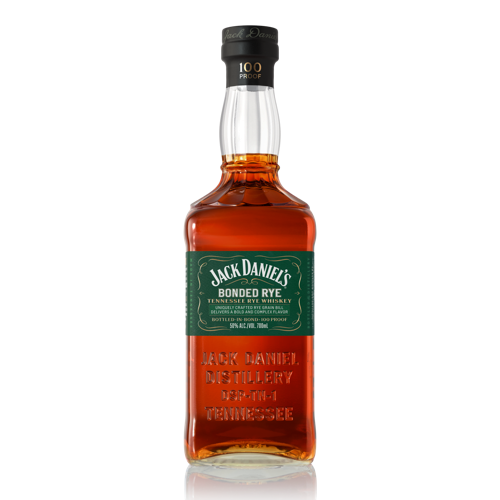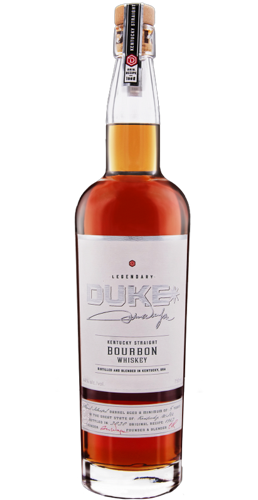
Two excellent new products have floated across my sampling transom lately — line extensions for Jack Daniel’s Distillery and Duke Spirits. The new Jack Daniel’s Bottled-in-Bond Rye Whiskey continues the distillery’s recent spate of innovation and expansion. Jack already had a rye whiskey in its portfolio, but this new product represents a nice improvement over the previous iteration.
The new rye shares the same mash bill as the original — 70 percent rye, 18 percent corn and 12 percent malted barley — but it is bottled at the legally required bond ABV of 50 percent, instead of the former 80 proof. During a recent virtual tasting session with Jack’s master distiller Chris Fletcher, he described the why behind the rye and the reasons to add it to their Bottled-in-Bond series, which debuted 18 months ago with Jack Daniel’s Bonded Tennessee Whiskey and Jack Daniel’s Triple Mash.
“It was sort of a no-brainer,” Fletcher explained. “There was no reason to overthink it. The other two bonded whiskeys have been well-received, and our rye is the backbone of our Triple Mash.” The distillery first began distilling rye whiskey back in 2011, releasing an unaged version and a 2-year-old, along the way to a fully aged product, to demonstrate how the liquid was changing in the barrel. Single barrel ryes have also been a very popular spirit for Jack Daniel’s as part of special releases.
The 100-proof level is an excellent choice, in my opinion. Fletcher agrees. “100 proof works well for a couple of reasons,” he shared. “Number one, it’s interesting and complex enough to be enjoyed neat. Second, it’s the perfect proof for classic cocktail combinations like a Manhattan or a boulevardier. I feel like it demonstrates plenty of rye character in the midpalate along with interesting top notes, but the rye is not too overt and forward. You don’t have to cover it up in a cocktail. So it’s a perfect classic whiskey cocktail base.”
Since bonded whiskey must come from a single distilling season, Fletcher has chosen a specific lot of 7-year-old rye distilled in the spring of 2016. Of course this is an easier thing to do for a huge distillery like Jack Daniel’s. Where a small craft distillery might have to cobble months' worth of production to create a new brand extension under the bonded whiskey regulations, Jack can probably pick a week’s worth and move forward. This does mean the new rye will change a little bit from year-to-year since they won’t be able to blend as many different ages of barrels to create a completely consistent product, but we just call that “character.”
Because there is a smaller percentage of corn in the mash bill, Bonded rye only passes through three feet of charcoal during the Lincoln County mellowing process, instead of the standard 10 feet that Old No. 7 travels through. Less charcoal means the character of the rye isn’t stripped away in an attempt to mellow the corn.
After mellowing, Jack Daniels Bottled-in-Bond Tennessee Rye Whiskey is aged in new oak barrels that have been toasted for 13 minutes under a gentle flame and then torched briefly to introduce a level of char on top of the toast. The result is a gentler rye that exhibits notes of green apple on the nose (primarily from the proprietary yeast that Jack uses), and brown sugar and caramel on the tongue. I noticed it really opens up nicely after a few minutes in a snifter to expose even more of those delicious chocolate aromas and flavors, instead of the usual overpowering fall spices that are the standard in rye whiskeys.
Like the other members of Jack’s Bonded collection, this new rye has been released in a 700-milliliter bottle with an MSRP around $31.99 per bottle. I noted that the proof premium to 80 to 100 pretty much balances out the fact that there is less whiskey in the bottle and asked Fletcher if he worried that this would cannibalize the original rye product, because I would drink this higher-proof product over the original 10 out of 10 times.
It turns out I was a little prescient, because Jack is eliminating the original product in favor of this new rye whiskey. I can’t say I’m mad about that. I’m also not upset about the move to the smaller bottle in recent new releases. While Fletcher wouldn’t admit whether this will be the new standard for all of their products going forward, he did acknowledge that sourcing one bottle size is a tremendous advantage with regard to the company’s supply chain, and that glass is a huge part of the expense of their products considering that every single bottle has to travel via truck out of the small holler in Lynchburg until it reaches, say, Shanghai.
Speaking of international logistics, thanks to various special releases and the requirements of different countries’ standards, Jack’s flagship Old No. 7 Tennessee Whiskey occupies literally hundreds of skus in their portfolio. My favorite is the square 1.5-liter bottle with the label intentionally applied upside-down so that it reads correctly in the automated 25-milliliter pour spouts commonly seen behind the bar in British pubs.
No matter what size bottle Jack chooses to sell this rye in, it will be a regular occupant of my home liquor shelf, and I’m happy to find another affordable everyday rye with a Tennessee flavor.

It’s been a few years since I first told you all about Duke Bourbon, a sourced whiskey from a company started by John Wayne’s son Ethan. Since then, the company has expanded their portfolio to include some tequilas and top-shelf premium whiskeys, but it had been a while since I sampled their Kentucky Straight Bourbon Whiskey, and it was well worth the wait.
The original liquid was supposedly sourced from two of John Wayne’s favorite distilleries (so certainly Wild Turkey was in the mix) and then blended into a final product. Since then, Duke Spirits has entered into a partnership with O.Z. Tyler Distillery, formerly known as Green River Distilling, in Owensboro, Ky. Together they have developed a high corn mash bill 88-proof bourbon that is aged five years before bottling, and I think it’s a marked improvement over the original. Sorry, Mr. Wayne.
The sweetness of the corn is still apparent in the glass, but there are also delightful carob and toasted coconut notes that I really enjoyed, especially as the base of an Old Fashioned I mixed up at home. The sweetness and citrus of the other ingredients in the cocktail played very nicely with the chocolate of Duke Bourbon. I also think Duke would make an excellent base for whiskey-forward tiki cocktails, like a Halekulani. I didn’t have any pineapple juice in the house or a few of the other necessary ingredients in my home bar to try it out, but I will soon.
At about $50 a bottle, Duke Kentucky Straight Bourbon Whiskey is worth seeking out.






